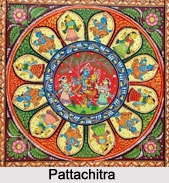 Traditional Indian Paintings are as old and varied as the land itself. The painting as a form of art has started in India since the prehistoric times. The earliest paintings in India is found on the walls of the caves in Bhimbetka in Madhya Pradesh where the prehistoric men engraved and painted the scenes from game, the animals and man in the simple geometric lines and colours on the cave walls.
Traditional Indian Paintings are as old and varied as the land itself. The painting as a form of art has started in India since the prehistoric times. The earliest paintings in India is found on the walls of the caves in Bhimbetka in Madhya Pradesh where the prehistoric men engraved and painted the scenes from game, the animals and man in the simple geometric lines and colours on the cave walls.Traditional Indian Paintings are India's pride. They truly replicate India's ancient tradition and inheritance. Since time, these paintings have decorated the walls, homes and courtyards of the villagers, people and tribals. Indian traditional paintings present an artistic range which expands from the early development to the present day. From being basically spiritual in reason in the establishment, Indian painting has developed over the years to turn out to be a combination of various cultures and traditions.
History of Traditional Indian Painting
Opening with the ancient rock cut paintings and murals, the Indian art traditions range around 8,000 years. Bhimbetka caves in Madhya Pradesh are the best example of pre-historic cave paintings and murals. The paintings of Indus valley was more preceded and it was during this time that the better paintings tools and techniques were developed. The subject and themes of paintings were quite fundamental. It is assumed that it was throughout this period only that people had started to paint and carve their deities. The influences of cultures and more significantly, the spiritual beliefs of the artists are quite apparent in their paintings.
Themes of Traditional Indian Painting
Themes of Traditional Indian Painting include representation of festivities, occasions, and gatherings. The themes are various and consist of a portrayal of hunting parties, war scenes.
Types of Traditional Indian Painting
The different forms of traditional painting in India is therefore vivid and lively, refined and sophisticated, while bold and vigorous at the same time and still have the aesthetic value to the connoisseurs and art-collectors of India and abroad.
For more visit the link below: